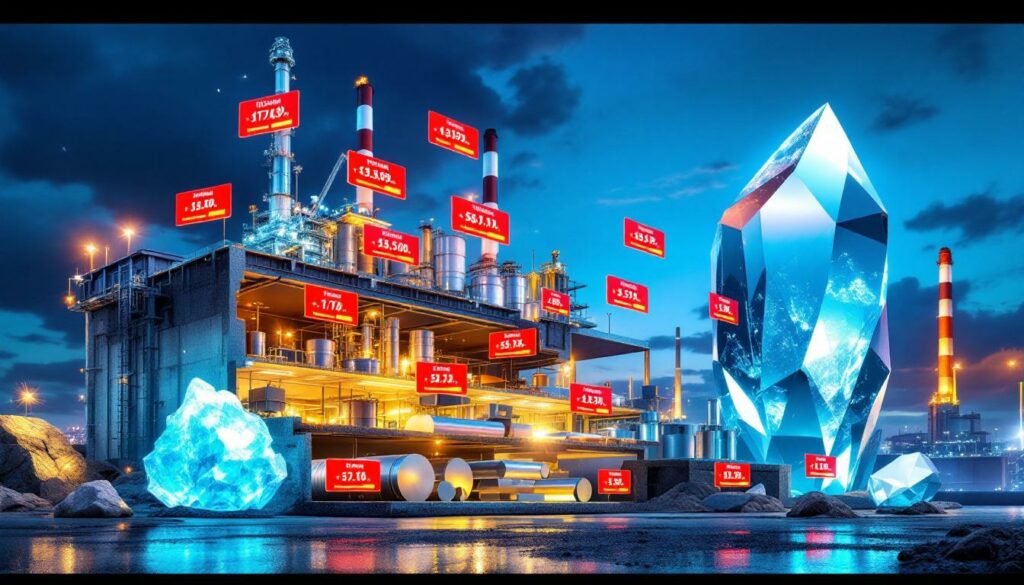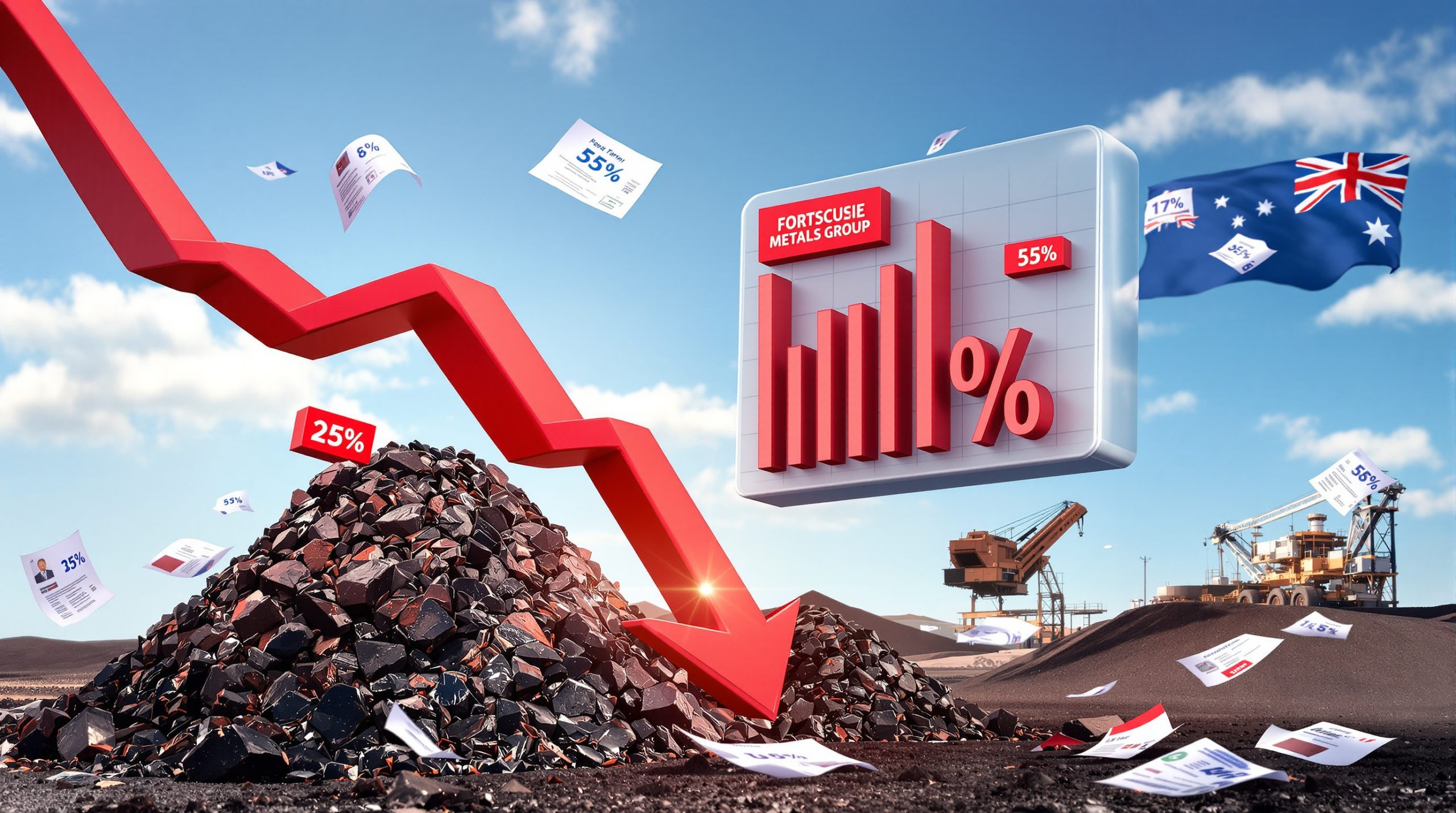What's Happening in the Titanium Concentrate Market?
The titanium concentrate market is experiencing a significant downward trend as prices continue to fall across domestic production channels. According to the latest data from Shanghai Metal Market (SMM), domestically produced titanium concentrate with TiO2 content of 46% or higher has fallen to 1,650-1,700 yuan per metric ton, representing a decline of 50 yuan/mt from previous assessments.
Higher-grade titanium concentrate with TiO2 content of 47% or above is currently trading at 1,950-2,100 yuan/mt, with average prices similarly dropping by 50 yuan/mt. This price differentiation highlights how quality continues to command premium pricing even in declining markets, with higher-grade materials maintaining an 18-24% price advantage over standard grades.
Current Price Movements and Trends
The price decline has accelerated in recent weeks due to a combination of market pressures. Most notably, imported ore prices have fallen by approximately 25% year-to-date, creating substantial downward pressure on domestic concentrate producers who must remain competitive.
"Weak titanium dioxide demand and falling imported ore prices have driven domestic miners to panic selling, exacerbating price declines," notes SMM in their July 2025 Industrial Metals Report.
This panic selling phenomenon has become increasingly evident as miners attempt to secure cash flow in an uncertain market, further accelerating the downward price trajectory beyond what fundamental factors might otherwise dictate.
Key Factors Driving the Decline
The titanium concentrate price decline stems from multiple interconnected factors:
- Weakening downstream demand: Reduced titanium dioxide consumption has created ripple effects throughout the supply chain, with decreased orders flowing upstream to concentrate suppliers
- Import competition: Foreign ore entering the market at reduced prices has pressured domestic producers to match competitive rates or lose market share
- Supply-demand imbalance: Production capacity continues to exceed current market requirements, creating persistent downward price pressure
- Seasonal factors: Traditional summer slowdown in construction and manufacturing sectors has further dampened demand during an already challenging period
Industry analysts suggest this combination of factors has created a particularly challenging environment for titanium concentrate producers, with market equilibrium unlikely to return until downstream demand strengthens or significant production cuts are implemented.
How Are Midstream Titanium Products Performing?
The midstream titanium sector, which bridges raw materials and finished products, is experiencing significant price pressures that reflect broader industry evolution trends. These intermediate products serve as critical indicators of overall market health, highlighting transmission effects between upstream and downstream segments.
Titanium Slag Market Conditions
High-titanium slag with TiO2 content of 90% or higher has seen prices fall to 6,300-7,000 yuan/mt according to SMM data. This represents a substantial single-day decline of 195 yuan/mt and an even more concerning monthly drop of 390 yuan/mt from the previous low point established in June.
The slag market's rapid deterioration stems from production inefficiencies that have emerged as producers operate under increasingly constrained margins. Smelting operations for ilmenite (the primary titanium slag feedstock) become less economically viable as market prices approach production cost thresholds.
"Steel mill tender reductions directly pressured titanium tetrachloride pricing, reflecting downstream industrial demand contraction," reports SMM's Market Analytics Team. This interconnection between industrial sectors highlights how titanium's value chain vulnerabilities extend beyond the immediate industry.
Titanium Tetrachloride Price Analysis
Titanium tetrachloride (TiCl4), a crucial intermediate compound used in both titanium metal and titanium dioxide production, has similarly experienced price degradation. Current prices for high-purity titanium tetrachloride (99.9%) range between 5,200-5,600 yuan/mt, representing a 100 yuan/mt decrease in the latest assessment.
The price decline correlates directly with reduced steel mill tender prices, which have dropped approximately 15% month-over-month according to SMM data. This relationship highlights how adjacent industrial sectors influence titanium intermediate product pricing.
Key factors affecting titanium tetrachloride include:
- Reduced steel production: Lower steel output has decreased demand for titanium additives
- Chloride process capacity adjustments: TiO2 producers using the chloride process have reduced operating rates
- Feed material economics: Raw material cost reductions have been partially offset by energy cost increases
- Inventory management: Buyers are delaying spot purchases to capitalize on the falling price environment
Major steel producers, including industry leaders like Baowu Group, have strategically delayed spot purchases to leverage the declining price environment, further contributing to market weakness.
What's the Current State of Titanium Materials?
The titanium materials segment, encompassing finished and semi-finished titanium metal products, is experiencing downward price pressures consistent with trends observed in other parts of the industry chain. This sector provides critical insight into how raw material challenges ultimately affect finished products across aerospace, medical, chemical processing, and other advanced manufacturing applications.
Titanium Product Price Movements
Current titanium product prices reported by SMM reflect the broader market downtrend:
| Product | Specification | Current Price (yuan/kg) |
|---|---|---|
| TA2 titanium plate | 3-8mm thickness | 64 |
| TA2 titanium tube | 25*2mm | 125 |
| TA1 pure titanium rod | 20-40mm diameter | 105 |
| TC4 titanium alloy rod | 20-40mm diameter | 125 |
These figures reveal important market dynamics, particularly the premium commanded by alloy products over pure titanium. TC4 titanium alloy rods maintain a 19% price premium over TA1 pure titanium rods of similar dimensions, reflecting the value-added nature of aluminum and vanadium additions that enhance strength-to-weight ratios for aerospace and high-performance applications.
Medical implant manufacturers have reportedly delayed procurement amid ongoing price uncertainty, adopting a wait-and-see approach that further dampens immediate demand.
Sponge Titanium Market Dynamics
Sponge titanium, the primary feedstock for titanium metal production, shows clear signs of exiting its previous high consolidation phase and entering a pronounced downtrend. SMM analysts note that supply increases have coincided with relatively stable but fragile demand from aerospace and medical sectors.
"Sponge titanium's exit from high consolidation signals supply growth outpacing stable-but-fragile demand in aerospace/medical sectors," according to SMM's Non-Ferrous Metals Desk.
Industry projections suggest sponge titanium could experience an additional 8-12% price decline before finding stability, particularly as production increases have outpaced demand growth. This situation creates favorable conditions for downstream fabricators but places significant pressure on primary producers.
Market factors driving sponge titanium trends include:
- Production capacity increases: New and restarted capacity has created oversupply conditions
- International market dynamics: Price disparities between regions have led to increased import competition
- Inventory management strategies: Producers working to balance production cuts against market share concerns
- Energy cost variations: Regional energy price differences affecting production economics
The titanium materials segment faces a challenging adjustment period as market participants adapt to new price realities while maintaining production quality standards required for critical applications.
How Is the Titanium Dioxide Market Responding?
Titanium dioxide (TiO2), the primary end-use product representing approximately 90% of global titanium mineral consumption, is experiencing pronounced market weakness that reverberates throughout the entire industry chain. As the dominant application for titanium minerals, TiO2 market dynamics serve as the primary driver for upstream price movements.
Current Price Levels and Adjustments
Anatase-grade titanium dioxide, widely used in applications including paints, papers, plastics, and inks, is currently quoted between 11,500-12,000 yuan/mt according to SMM data. The average price stands at 11,750 yuan/mt, representing a significant 350 yuan decline from previous assessments.
This price level marks a 12.3% quarter-over-quarter decline, making it the weakest market since Q4 2024. Mainstream producers have implemented aggressive price adjustment policies in response to deteriorating market conditions, with varying degrees of discounting based on volume commitments and customer relationships.
"Anatase faces disproportionate pressure due to shrinking paint/coatings demand, while rutile holds marginal stability," reports SMM's Chemical Materials Division. This differentiation highlights how technical properties influence market performance, with anatase's lower UV resistance making it more vulnerable in premium applications compared to rutile grades.
Demand-Supply Dynamics
The titanium dioxide market exhibits clear signs of oversupply relative to current demand levels, creating persistent downward price pressure. Key factors influencing this imbalance include:
- Construction sector slowdown: Reduced paint and coating demand from building applications
- Consumer goods weakness: Lower consumption of plastics and finished products containing TiO2
- Inventory destocking: Buyers working through existing inventories before placing new orders
- Capacity utilization adjustments: Major producers including Chemours and Lomon Billions reducing operating rates by 15-20%
Market expectations increasingly point toward further price bottoming before stabilization can occur. The anatase segment faces particularly strong adjustment pressure due to its greater exposure to economically sensitive applications and higher substitution risk compared to rutile grades.
Technical note: Anatase and rutile are polymorphs of titanium dioxide with different crystal structures. Rutile offers superior opacity, UV resistance, and durability, commanding premium pricing for outdoor applications, while anatase provides better dispersibility and is often preferred for indoor applications.
Industry analysts anticipate that market equilibrium will only return once significant production capacity adjustments have been implemented or seasonal demand patterns improve in the fall.
What Factors Are Influencing the Overall Titanium Market?
Multiple interconnected factors are driving the current prices in the titanium industry chain, creating a complex market environment that affects participants across the value chain. Understanding these influences provides critical context for interpreting current conditions and projecting future developments.
Seasonal and Economic Pressures
The titanium market traditionally experiences seasonal demand fluctuations, with the summer months representing a characteristic low period. Current data from SMM indicates this seasonal effect correlates with an 18-22% demand reduction in construction and automotive sectors compared to peak periods.
"Oversupply, seasonal softness, and China's property sector slump form a perfect storm for titanium," notes SMM's Monthly Metals Review. This combination creates particularly challenging conditions as cyclical factors amplify structural market imbalances.
Macroeconomic pressures have further compounded these seasonal effects, with broader industrial metal demand showing signs of softening across multiple sectors. These pressures manifest differently across the titanium value chain:
- Raw materials: Reduced mine output utilization with selective high-grading of deposits
- Intermediate products: Compressed processing margins as input cost reductions lag finished product price declines
- Finished goods: Inventory management challenges as customers delay purchases anticipating further price reductions
The industry now faces inventory metrics showing producer stockpiles approximately 30% higher year-over-year, extending typical destocking timelines to 60-90 days compared to historical 30-45 day averages.
Regional Market Variations
Significant regional variations have emerged in the titanium market, creating both challenges and opportunities for different participants based on their geographic positioning. These variations reflect differences in:
- Energy cost structures: European producers face approximately 5% higher sponge titanium production costs compared to Asian counterparts due to energy price differentials
- Demand recovery patterns: Regional construction and manufacturing activity resumption varies significantly by geography
- Supply chain resilience: Transportation and logistics challenges affect different regions with varying severity
- Regulatory environments: Environmental compliance requirements create regionally variable cost structures
These regional differences create complex trade flows as market participants seek to leverage geographic arbitrage opportunities while managing logistics costs and lead time requirements.
Market insight: The titanium industry remains highly sensitive to regional economic policy shifts, particularly as they affect construction activity and durable goods manufacturing—two sectors that drive significant titanium consumption through both direct and indirect channels.
The combination of these factors creates a highly dynamic market environment requiring sophisticated monitoring of multiple indicators to accurately assess current conditions and future trends.
What's the Market Outlook for Titanium Products?
The titanium industry faces continued challenges in the near term, with potential stabilization emerging later in the year contingent upon several key market developments. Understanding both the timing and catalysts for potential recovery provides essential strategic context for industry participants.
Short-Term Projections
According to SMM analysis, titanium prices across the industry chain are expected to experience continued weakness through the remainder of summer, with potential bottoming occurring in August. This projection aligns with traditional seasonal patterns but is amplified by current supply-demand imbalances.
"Recovery hinges on end-use demand rebound by late August, coinciding with post-monsoon construction resumptions," forecasts SMM's Forecast Unit. This timeline provides a potential inflection point for monitoring market recovery signals.
Key factors shaping the short-term outlook include:
- Inventory destocking progress: Clearing of accumulated inventories throughout the supply chain
- Production curtailment implementation: Actual vs. announced capacity reductions by major producers
- Seasonal demand patterns: Timing and strength of traditional fall demand improvements
- Macroeconomic indicators: Broader manufacturing and construction activity metrics
SMM modeling suggests producer capacity cuts of 15% or greater would be required to achieve market rebalance under current demand conditions. Without such adjustments, price stabilization may require a longer timeframe or stronger demand recovery than currently anticipated.
This pattern shares similarities with the 2024 Q3 rebound, which followed a comparable summer slump before recovering as seasonal factors improved.
Key Indicators to Monitor
Industry participants should closely track several leading indicators to identify potential market stabilization or recovery signals:
-
Titanium scrap collection rates: Early indicator of metal production activity
-
Aerospace order backlogs: Forward indicator of high-grade titanium demand
-
End-use demand metrics:
- Construction starts (paint/coating demand)
- Automotive production rates (exhaust systems, springs)
- Chemical processing capital expenditures (reactor vessels, heat exchangers)
-
Producer operating rate announcements: Particularly from market leaders with price-setting influence
-
Raw material inventory levels: At both producer and consumer facilities
These indicators provide a comprehensive dashboard for assessing market conditions and identifying potential inflection points before they manifest in published price assessments.
Strategic consideration: The historical pattern suggests counter-cyclical purchasing opportunities may emerge in late August for well-capitalized buyers with storage capacity and predictable medium-term consumption requirements.
Market participants should prepare contingency plans for both continued weakness and potential stabilization scenarios to maintain operational flexibility as conditions evolve.
What Are the Implications for Different Market Participants?
The current titanium market environment creates distinct challenges and opportunities for different participants across the value chain. Strategic responses must be tailored to specific positions within the industry structure to effectively navigate this challenging period.
For Producers and Suppliers
Titanium producers and raw material suppliers face particularly acute challenges as prices approach or breach production cost thresholds. According to SMM data, producer margins have compressed to 8-12%, down from 15-18% in the first half of 2025, creating cash flow pressures and operational challenges.
Key strategic considerations for upstream participants include:
-
Cost optimization initiatives:
- Energy efficiency improvements
- Raw material yield enhancement
- Shift scheduling to capitalize on off-peak power pricing
- Maintenance timing to coincide with lowest margin periods
-
Production portfolio management:
- Focusing on higher-margin specialty grades where possible
- Temporarily reducing output of most challenged product lines
- Evaluating product mix to maximize contribution margin
-
Strategic inventory positioning:
- Balancing working capital concerns against market position
- Selective inventory builds of constrained inputs
- Just-in-time approaches for readily available materials
"Strategic inventory management separates resilient producers from distressed sellers in downcycles," advises SMM's Risk Advisory team. This distinction highlights how operational decisions during challenging periods often determine long-term competitive positioning.
Industry leaders like VSMPO-AVISMA have demonstrated the effectiveness of just-in-time inventory models in managing cyclical downturns while maintaining operational capability for eventual recovery.
For Buyers and End-Users
The current market environment presents potential opportunities for well-positioned buyers with financial flexibility and storage capacity. Spot market discounts currently averaging 5-8% above contract pricing create favorable conditions for opportunistic purchasing.
Buyers should consider several strategic approaches:
-
Tiered purchasing strategies:
- Maintaining minimum inventory through existing contracts
- Supplementing with spot purchases during price dips
- Extending coverage incrementally as prices approach perceived bottoms
-
Supplier relationship management:
- Balancing price advantages against reliability requirements
- Supporting strategic suppliers through volume commitments
- Developing new supplier relationships during buyer-favorable markets
-
Quality assurance vigilance:
- Increased verification during downturns when quality shortcuts may occur
- Maintaining specification requirements despite price pressures
- Understanding the quality-price relationship across different applications
-
Timing-based procurement strategies:
- Accelerating purchases of materials approaching historical price floors
- Delaying non-critical purchases during continued decline phases
- Establishing trigger points for increased procurement activity
For end-users, the challenging titanium market offers opportunities to secure favorable pricing while strategically positioning for eventual recovery. Organizations with counter-cyclical procurement capabilities can achieve significant cost advantages while ensuring supply continuity.
FAQ: Titanium Industry
Looking to Stay Ahead in the Titanium Market?
Discover significant price movements, regional variations, and strategic insights in the titanium sector with Discovery Alert's proprietary Discovery IQ model, delivering real-time market intelligence across the entire titanium value chain. Visit the Discovery Alert discoveries page to understand how timely information can transform your investment decisions in commodity markets.




